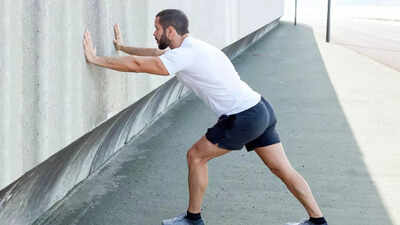Calf muscles are often overlooked during workouts, but they play a vital role in your overall health. From supporting daily movement and balance to potentially protecting against cognitive decline, strong calves do more than just power your steps. Recent research highlights a connection between smaller calf size and a higher risk of dementia, making lower leg strength an important marker for healthy ageing. Whether you’re aiming to boost stability, prevent injuries, or support brain function, including calf-focused exercises in your routine can make a significant difference in both physical and mental well-being.
The link between calf size and cognitive health
A study suggests that smaller calf circumference may be associated with reduced cognitive performance. Researchers found that individuals with sarcopenia (age-related muscle loss), which is often first noticed in smaller muscles like the calves, had a higher prevalence of dementia. The study further noted that sarcopenia is frequently accompanied by chronic, low-grade inflammation, a known risk factor for cognitive decline. Calf circumference is now recognised as a physical marker for sarcopenia in clinical settings. This indicates that weaker, shrinking calves could serve as an early warning sign for age-related cognitive issues.
7 Simple and effective calf-strengthening exercises
Strengthening the calves doesn’t require expensive equipment or a gym membership. Here are a few exercises recommended by physiotherapists and trainers that can be done at home:
Standing calf raises
These are excellent for targeting both major calf muscles. Stand with your feet hip-width apart, raise your heels as high as you can while pressing through the balls of your feet, and then slowly lower. Perform 2–3 sets of 10–15 reps, with rest periods of 30–60 seconds.
Seated calf raises
According to physiotherapist Joe Edwards, this variation focuses more on the soleus muscle. Sit on a chair with your toes elevated on a block. Keeping your back straight, lift your heels, hold briefly, and lower. Aim for three sets of 12–15 reps.
Uphill walking and hiking
Incline walking activates the gastrocnemius and soleus more than flat-surface walking. This improves endurance, builds muscle mass, and strengthens the ankles, all of which contribute to better mobility and reduced fall risk.
Eccentric heel drops
This is especially useful for tendon health and controlled strength building. Stand on a step, rise up on both feet, then lift one leg and slowly lower the heel of the other. Perform 10 reps per leg. This eccentric motion helps build both strength and flexibility.
Skipping
Often overlooked in adulthood, skipping re-engages the calf muscles through repetitive jumping. It’s also a cardio activity, improving heart health and endurance. Studies show jump-rope training enhances balance and coordination, particularly in children, but similar benefits are likely in adults.
Elevated squats
Using a folded yoga mat or dumbbell under your heels, perform a deep squat to engage more of your lower-leg muscle fibres. The elevated heel improves ankle mobility and allows for a deeper range of motion, which increases muscle activation.
Jumping Lunges
This dynamic exercise targets multiple lower body muscle groups, including the calves, and improves coordination and balance. Start with static lunges and gradually progress to jump switches, ensuring good form to avoid injury.Calf muscles are far more than just a support for movement; they’re indicators of strength, mobility, and even cognitive health. With growing evidence linking smaller calf size to sarcopenia and an increased risk of dementia, it’s clear that maintaining calf strength should be part of any well-rounded wellness plan. Fortunately, incorporating simple exercises like calf raises, uphill walks, and skipping can go a long way in building lower-leg strength. By prioritising these often-overlooked muscles, you’re not only enhancing stability and mobility but also investing in better long-term health, physically and mentally. Strong calves truly support a stronger future.Also Read: How to know when death is near: 11 health-related signs and what to expect in the final hours
